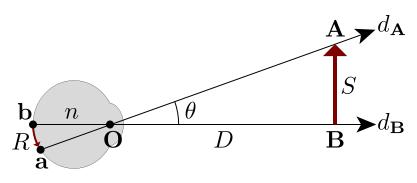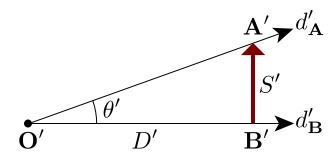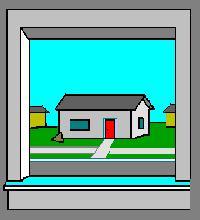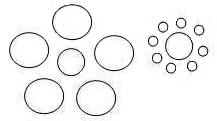
 or simply written in this form: θ = S / D (since tan θ = θ radians for the small angle approximation; thus, θ can substitute for tan θ).
or simply written in this form: θ = S / D (since tan θ = θ radians for the small angle approximation; thus, θ can substitute for tan θ).
The retinal images at b and a are separated by the distance R, given by the equation:
in which n is the eye's nodal distance that averages about 17 mm. That is, a viewed object's retinal image size is approximately given by R = 17 S/D mm or R = 17 θ mm. The line from point O outward through object point B specifies the optical direction, dB, of the object's base from the eye, which is directed toward the horizon. The line from point O through point A specifies that endpoint's optical direction, dA, toward some specific elevation value (say, 18 degrees). The difference between those real directions (dA - dB) is, again, the visual angle θ. Also, the visual angle θ is the perceptual correlate of the "size" of the retinal separation R mm, or it is approximately the equivalent of the retinal image size. In other words, we cay say that θ is mediated by the retinal image size R mm or the retinal image R mm is directly valuated (or scaled) by θ.

The diagram above illustrates the perceived (subjective) values for a viewed object. Point O′ represents the place from which the observer feels that he or she is viewing the world; D′ is the perceived distance of the subjective point B′ from O′. The observer might simply say how far away point B′ looks, in inches or meters or miles. Similarly, S′ is the perceived linear extent by which the subjective point A′ appears directly above point B′. The observer could simply say how many inches or meters that vertical distance looks. For a viewed object, S′ thus is its perceived linear size in meters, (or apparent linear size). The perceived endpoint at B′ has the perceived direction, d′B, and the observer might simply say "it looks straight ahead and toward the horizon." The object's other perceived endpoint, A′, has a perceived direction d′A, about which the observer might say "it appears toward a higher elevation than point B′." The difference between the two perceived directions (d′A - d′B) is the perceived visual angle θ′, also called the perceived angular size or apparent angular size.
It is, however, deemed to be very hard to quantify θ′. For instance, some observers might say that point A′ "looks about 25 degrees higher" than B′, but most of us cannot reliably say how large a direction difference looks. We often rely on pointing gestures to suggest the perceived visual angle; for instance, we often tell someone about the change in the directions we see for two viewed points by pointing something, e.g., a finger or our eyes from one point to the other. Therefore, in some experiments the observers aimed a pointer from one viewed point to the other; so the angle through which the pointer rotated was the measure of θ′. Also, because θ′ specifies the amount by which one should rotate one's eye to quickly look from one seen point to another eye tracking, observers in other experiments shifted their gaze from one object endpoint to the other, and the angle the eye rotated through was measured as θ′ for that object.
It is believed to be important to understand how θ′ differs from S′. An example is illustrated by the sketch on the right. Suppose we are looking through a window at a 30-foot-wide (9.1 m) house 240 feet away, so it subtends a visual angle of a
 bout 7 degrees.
The 30-inch-wide
(760 mm) window opening is 10 feet away, so it subtends a visual angle of 14
degrees.
We can say the house "looks larger and farther away" than the window, meaning
that the perceived linear size S′ for the house's width is much larger
than S′ for the window;
for instance a person might say the house "looks
about 40 feet wide" and the window "looks about 3 feet wide."
We also can say the house "looks smaller and farther away" than the window,
and that does not contradict the other statement because now we mean that the
amount (θ′) by which directions of the house's edges appear to differ is,
for instance,
about half the apparent direction difference for the window
edges. As such, we experience both the linear size and the angular
size comparisons at the same time, along with the distance comparison.
Thus any report that states merely that one object "looks larger" than another object
is considered to be ambiguous.
It is required to specify whether "looks larger" refers to the perceived
angular size (θ′) or to the perceived linear size (S′) or to both
of those qualitatively different "size" experiences.
It is believed that in everyday conversations "looks larger"
often refers to an angular size comparison rather than a linear size
comparison.
bout 7 degrees.
The 30-inch-wide
(760 mm) window opening is 10 feet away, so it subtends a visual angle of 14
degrees.
We can say the house "looks larger and farther away" than the window, meaning
that the perceived linear size S′ for the house's width is much larger
than S′ for the window;
for instance a person might say the house "looks
about 40 feet wide" and the window "looks about 3 feet wide."
We also can say the house "looks smaller and farther away" than the window,
and that does not contradict the other statement because now we mean that the
amount (θ′) by which directions of the house's edges appear to differ is,
for instance,
about half the apparent direction difference for the window
edges. As such, we experience both the linear size and the angular
size comparisons at the same time, along with the distance comparison.
Thus any report that states merely that one object "looks larger" than another object
is considered to be ambiguous.
It is required to specify whether "looks larger" refers to the perceived
angular size (θ′) or to the perceived linear size (S′) or to both
of those qualitatively different "size" experiences.
It is believed that in everyday conversations "looks larger"
often refers to an angular size comparison rather than a linear size
comparison.
Here, S′ is typically called the "perceived size" or "apparent size";
more precisely it is the perceived linear size, measured in meters.
When rearranged as S′ = D′·θ, the equation expresses Emmert's law (which will be discussed in the next article).
The perceived visual angle has
been used to explain the Ebbinghaus illusion, for instance. In the
Ebbinghaus illusion figure on the right,
the two central circles are the same linear size S and the same
viewing distance D; so they subtend the same visual angle θ and
form equal-sized retinal images (see the previous article for details). But the right central circle "looks larger" than the left
one.
According to the SDIH, "looks larger" can mean only that S′ is
greater, and with the physical angle θ the same for both, the SDIH
requires that D′ be greater for the right circle  than for the left one.
However, for most observers, both circles appear unequal while also appearing at
the same distance (on the same page). This commonly found disagreement between published data and the SDIH is known
as the "size-distance paradox".
The "paradox" completely vanishes, according to McCready, when the illusion is described,
instead, as basically a visual angle illusion:
that is, the perceived visual
angle θ′ is larger for the right central circle than for the left central circle. It is
as if its retinal image were larger. So, according to the "new" perceptual
invariance hypothesis
(θ′ = S′/D′), with θ′
larger for the right circle, and with D′ correctly the same for both
circles, then S′ becomes larger for the right one by the same ratio that
θ′ is larger.
As a consequence, the right central circle looks a larger linear
size on the page is because it looks a larger angular size than the left
one.
than for the left one.
However, for most observers, both circles appear unequal while also appearing at
the same distance (on the same page). This commonly found disagreement between published data and the SDIH is known
as the "size-distance paradox".
The "paradox" completely vanishes, according to McCready, when the illusion is described,
instead, as basically a visual angle illusion:
that is, the perceived visual
angle θ′ is larger for the right central circle than for the left central circle. It is
as if its retinal image were larger. So, according to the "new" perceptual
invariance hypothesis
(θ′ = S′/D′), with θ′
larger for the right circle, and with D′ correctly the same for both
circles, then S′ becomes larger for the right one by the same ratio that
θ′ is larger.
As a consequence, the right central circle looks a larger linear
size on the page is because it looks a larger angular size than the left
one.
As already introduced,
the magnitude of an object's visual angle θ
is believed to determine the size R of its retinal image. In turn, the size of the retinal
image is believed to determine the extent of the neural activity pattern the retina's
neural activity eventually generates in the primary visual cortex, area V1 or Brodmann area 17.
This cortical area is thought to harbor a
distorted but spatially isomorphic "map" of the retina, which has presumably been confirmed by Murray, Boyaci, & Kersten (2006) using functional magnetic resonance imaging.